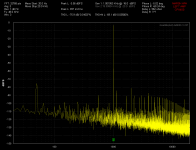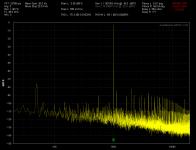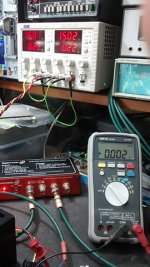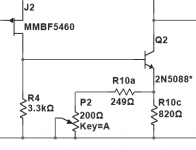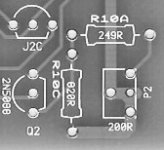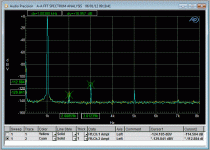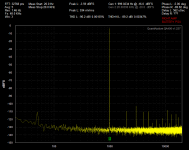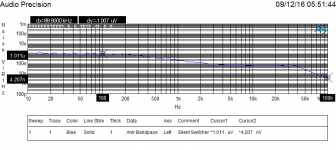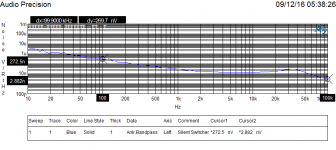BTW - I found the transistor kits from Tech-DIY to all be closely matched. The kit of semiconductors includes all needed matched pairs to make one channel. Buy two and the savings in time and money may be worth it. If you do not want to do the matching yourself, buying them already matched for you is a good way to go.
THx-RNMarsh
THx-RNMarsh
FFT is always nice.
See attached.
Mains here is 50Hz.
Switched to the bench psu, both amps pulling a steady 220mA and meter shows typical dialled in long term dc offset value exhibited by both amplifiers.
Attachments
Thank you for your reply.
Zero balance trim pot settings are fine and hold beautifully, issue is with secondary pots.It looks like you did not match all the devices. Notable is that the zero balance trim pot is all the way to one side. With matched pairs/compliments, the trim pot should be near centered.
Please see the QA400 screens in my reply to Jack.FFT should add to this info....
Secondary pots? where are those placed? And values?
Looks like -82 and -90db are the 2H and 3H levels shown.
Proably all working but needs matching of all devices.... not only input stage. This is because the circuit does Not depend on a lot of negative feedback to lower THD.
Also, depends on the symmetry and ac and dc balance of the circuit.
BTW -- have you listened AS-IS to get a feel for the potential?
THx-RNMarsh
Looks like -82 and -90db are the 2H and 3H levels shown.
Proably all working but needs matching of all devices.... not only input stage. This is because the circuit does Not depend on a lot of negative feedback to lower THD.
Also, depends on the symmetry and ac and dc balance of the circuit.
BTW -- have you listened AS-IS to get a feel for the potential?
THx-RNMarsh
Last edited:
Secondary pots? where are those placed? And values?
I've pm'd you a link to a set of pcb scans so you can see what's going on with the mentioned secondary pots.
Looks like -82 and -90db are the 2H and 3H levels shown.
Proably all working but needs matching of all devices.... not only input stage. This is because the circuit does Not depend on a lot of negative feedback to lower THD.
Also, depends on the symmetry and ac and dc balance of the circuit.
Like I said previously, I'm looking at this build as the first iteration.
Lolz, frustratingly no as I lent my AKG headphones earlier last week for a comparison session. Get them back later this week and will report back aural impressions thereafter.BTW -- have you listened AS-IS to get a feel for the potential?
With the addition of the trimpot P2, and 820R (R10C) the value of R10 in the original schematic, Figure 8 of the Linear Audio article, swings from 190R to 290R affording some flexibility.
Mark, you've also got power supply issues witnessed on the FFT -- don't use a lab supply, just a simple bipolar supply with CRC filter, no regulator...and your testing setup looks, well, just a bit "un-tidy".
Jack. yes, i recall doing that... trim for fine ac balance. That was to get an all compl matched circuit to be even closer for extremely low thd. As an option. But I was well under -100 then.
I am thinking of placing the full original schematic here -- maybe even the article... because I asked to retain all copy rights and now the magazine is shutting down operations.
Because there is significant noise pickup shown ... that reminded me that grounding will affect thd readings also. Be sure it is all star grounded and grounded in proper order.... signal and power.
and eliminate ground loops via test equipment and computer and pwr supplies and gen. to get lowest readings.
What is the THD of the generator you are using?
THx-RNMarsh
I am thinking of placing the full original schematic here -- maybe even the article... because I asked to retain all copy rights and now the magazine is shutting down operations.
Because there is significant noise pickup shown ... that reminded me that grounding will affect thd readings also. Be sure it is all star grounded and grounded in proper order.... signal and power.
and eliminate ground loops via test equipment and computer and pwr supplies and gen. to get lowest readings.
What is the THD of the generator you are using?
THx-RNMarsh
Last edited:
Mark, you've also got power supply issues witnessed on the FFT -- don't use a lab supply, just a simple bipolar supply with CRC filter, no regulator...and your testing setup looks, well, just a bit "un-tidy".
I assume that therefore is what you're using, perhaps it would make sense for me to use same?
Because there is significant noise pickup shown ... that reminded me that grounding will affect thd readings also. Be sure it is all star grounded and grounded in proper order.... signal and power.
and eliminate ground loops via test equipment and computer and pwr supplies and gen. to get lowest readings.
What is the THD of the generator you are using?
Point taken about the grounding.
The Lindos signal generator THD spec is <=0.005% @ 1kHz.
What is the THD of the generator you are using?
THx-RNMarsh
I'm using the AP SYS2722 which is down near 0.00022% for one channel and 0.00020% for the other.
Attachments
Out of curiosity ran the hp amps off a pair of Yuasa 12v lead acid batteries and hooked the QA400 up to a laptop running on batteries.
Most def need to better match T1 & T2 on the left amp to get some usable track back on the second pot. Right amp second pot on sweet spot for minimum distortion via T1 & T2.
Pick my cans up tomorrow and then will be able to give the amps a listen.
Most def need to better match T1 & T2 on the left amp to get some usable track back on the second pot. Right amp second pot on sweet spot for minimum distortion via T1 & T2.
Pick my cans up tomorrow and then will be able to give the amps a listen.
Attachments
I experience much the same thing when using my Tek PS5010 lab supply. It's great for initial testing but not for tweaking.
I would hope that Jan would design his switching power supply for somewhat higher current. This would allow the Marsh HPA to be powered by a wall-wart.
I would hope that Jan would design his switching power supply for somewhat higher current. This would allow the Marsh HPA to be powered by a wall-wart.
I would hope that Jan would design his switching power supply for somewhat higher current. This would allow the Marsh HPA to be powered by a wall-wart.
If you are referring to the Silent Switcher and a wall wart, some wall wart switching hash can make it though the SS to the output.
Even running on a clean 5v linear PS there is still something not quite up to very clean linear PS HF noise performance from SS, at least in my experience.
Last edited:
The maximum current by the SS depends on output voltage and is limited by the chip set used to generate the bipolar voltages.
To go higher on current means a completely new design with another chipset.
Patrick
To go higher on current means a completely new design with another chipset.
Patrick
Out of curiosity ran the hp amps off a pair of Yuasa 12v lead acid batteries and hooked the QA400 up to a laptop running on batteries.
Most def need to better match T1 & T2 on the left amp to get some usable track back on the second pot. Right amp second pot on sweet spot for minimum distortion via T1 & T2.
Pick my cans up tomorrow and then will be able to give the amps a listen.
🙂 😎
-RM
If you are referring to the Silent Switcher and a wall wart, some wall wart switching hash can make it though the SS to the output.
Sorry, there's no switching noise on the Silent Switcher bleeding through from a wall wart.
Attachments
Varies somewhat with the particular wall wart but yes there is, or can be. Affects the sound of an ES9038Q2M DAC. Accidentally plugging the SS into a USB hub resulted in clicking and beeping noises coming out of the DAC. Some of it may be up at a few MHz, but there is something there.
just looked it on my HP3577a 10kHz to 100MHz-- the only thing I see is a 10MHz signal -92dBm, and this may be environmental, it's ~6uV into a 50 Ohm load.
If there exists clicking which you hear, it is probably a problem with a USB Hub being over-taxed with some kind of periodicity.
Getting off-topic here, lets weave back into the flow of traffic wrt Dr. Marsh's headphone amp.
If there exists clicking which you hear, it is probably a problem with a USB Hub being over-taxed with some kind of periodicity.
Getting off-topic here, lets weave back into the flow of traffic wrt Dr. Marsh's headphone amp.
- Home
- Amplifiers
- Headphone Systems
- Marsh headphone amp from Linear Audio
